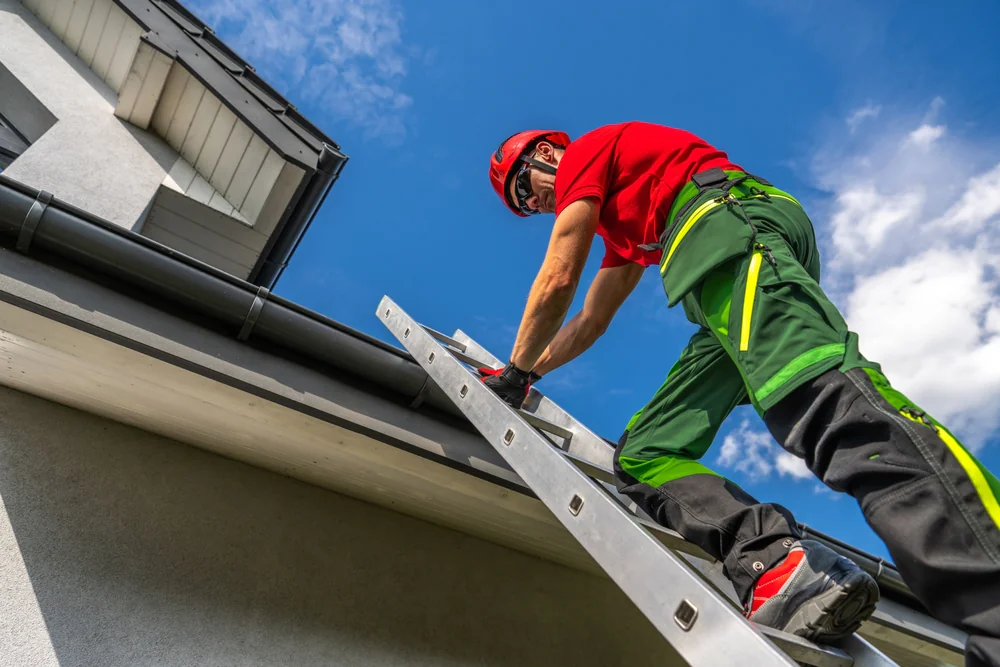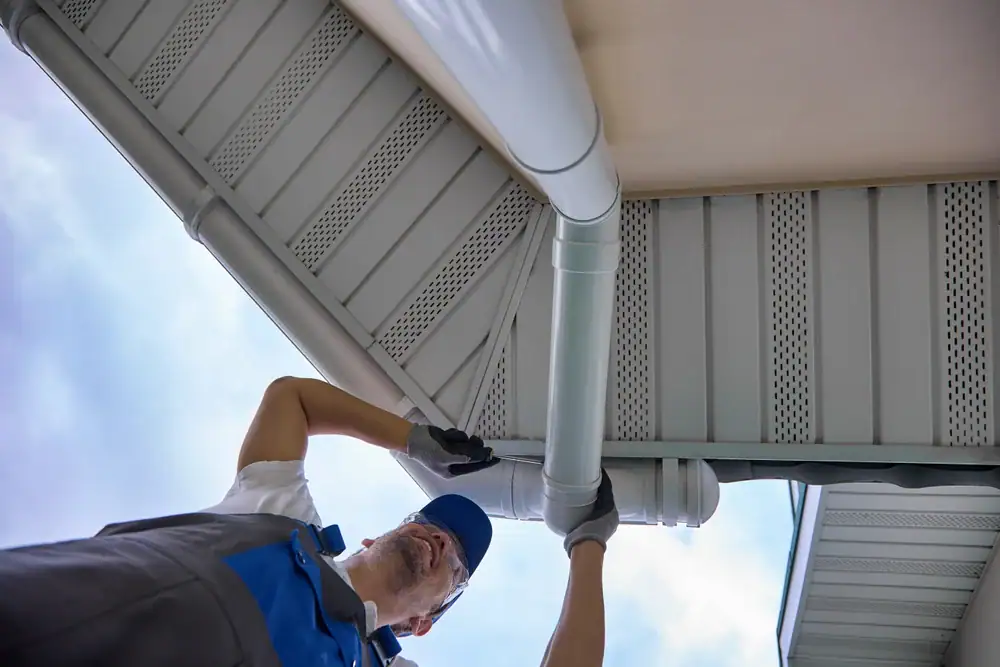Your roof's performance depends on more than just shingles - gutters, fascia, and flashing work together to protect your Suffolk County home.
Share:

Summary:
Your gutters aren’t just an add-on to your roofing system – they’re an integral part that directly impacts how well your entire roof performs. When gutters function properly, they collect thousands of gallons of water each year and direct it safely away from your home’s foundation and structure.
But here’s what many homeowners don’t realize: clogged or damaged gutters create a domino effect that compromises your roof’s ability to protect your home. Water backs up, sits against your roof edge, and finds ways to seep into areas where it doesn’t belong.
This standing water accelerates the aging of your roofing materials and can cause your fascia boards to rot, creating weak points in your roof’s defense system.

When gutters can’t handle the water load from your roof, several problems develop that directly impact roof performance. Overflowing gutters dump water against your home’s siding and foundation, but the damage starts at the roof line.
Water that should flow into your gutters instead pools along the roof edge. This standing water works its way under shingles, especially during Suffolk County’s frequent storms and heavy rains. Once water penetrates your roofing system, it reaches the underlying wood structure and begins the rot process.
The fascia boards that support your gutters become saturated and start to deteriorate. As these boards weaken, your gutters pull away from the house, creating gaps that allow even more water to enter. What started as a simple gutter cleaning issue becomes a structural problem requiring fascia replacement, roof repairs, and potentially more extensive home construction work.
Ice dams during Suffolk County’s harsh winters make this problem even worse. When gutters can’t drain properly, ice builds up and forces water back under your shingles. This freeze-thaw cycle damages roofing materials and creates leaks that might not show up until spring.
Regular gutter maintenance prevents these cascading problems. Clean gutters with proper pitch allow water to flow freely, protecting your roof’s edge and maintaining the integrity of your entire roofing system.
Your roof’s performance depends heavily on your gutters’ ability to handle the volume of water coming off your roof surface. Suffolk County homes face significant rainfall throughout the year, plus heavy snow loads that create large volumes of melt water in spring.
Undersized gutters or gutters with insufficient downspouts can’t handle these water loads effectively. When water overflows, it doesn’t just damage your landscaping – it compromises your roof’s ability to shed water properly. The overflow creates erosion around your foundation and can cause water to back up under your roof’s edge.
Properly sized gutters with adequate downspouts ensure your roof can do its primary job: keeping water out of your home. The water collection system needs to match your roof’s square footage and the typical rainfall in your area. Most homes need at least one downspout for every 20-30 feet of gutter, but steep roofs or areas with heavy rainfall may need more.
Seamless gutters perform better than sectional gutters because they have fewer joints where leaks can develop. These leaks might seem minor, but they allow water to drip behind the gutter system and contact your fascia boards and roof structure.
When gutters are properly installed with the right capacity and pitch, your roof performs as designed. Water flows off the shingles, into the gutters, and away from your home without creating stress points or areas where moisture can accumulate and cause damage.
Want live answers?
Connect with a Home Team Construction expert for fast, friendly support.
Fascia boards and flashing might not be the most visible parts of your roof, but they’re absolutely critical to its performance. These components create the watertight seal between your roof and the rest of your home’s structure.
Fascia boards support your gutters and provide a finished edge to your roofline. When they’re in good condition, they create a solid mounting point for your gutter system and help maintain proper water flow.
Flashing – those thin strips of metal installed at joints and transitions – directs water into your gutters instead of allowing it to seep behind them. Together, these elements ensure water follows the path you want it to take.

Roof flashing serves as your roof’s traffic director for water, and its condition directly affects how well your entire roofing system performs. This thin metal barrier installed where your roof meets your gutters prevents water from sneaking behind your gutter system and into your home’s structure.
Without proper flashing, water running off your roof can bypass your gutters entirely. Instead of flowing into the collection system, it runs down behind the gutters and soaks into your fascia boards and roof sheathing. This creates the perfect conditions for rot, mold, and structural damage.
Gutter flashing, also called a gutter apron, extends from under your shingles down into your gutter channel. When it’s properly installed, every drop of water from your roof ends up in your gutters where it belongs. When flashing is missing, damaged, or improperly installed, water finds alternative paths that compromise your roof’s performance.
Many older homes in Suffolk County were built without adequate flashing, or the existing flashing has deteriorated over time. Aluminum and galvanized steel flashing can last decades, but exposure to weather and seasonal temperature changes eventually causes expansion and contraction that creates gaps.
Signs you need flashing attention include water stains on your fascia boards, dripping from the middle of gutter sections, or visible gaps between your roof edge and gutter system. Addressing flashing problems quickly prevents minor issues from becoming major roof performance problems.
Professional installation ensures flashing overlaps properly and creates a continuous barrier that directs water where it should go. This small investment in proper flashing dramatically improves your roof’s ability to protect your home.
Your fascia boards do much more than provide a clean finished look to your roofline – they’re structural components that directly impact your roof’s performance. These horizontal boards support your gutter system and help maintain the proper slope needed for effective water drainage.
When fascia boards are solid and properly maintained, they provide a stable mounting surface for gutters. This stability ensures gutters maintain their proper pitch and alignment, which is critical for effective water flow. Even small changes in gutter slope can cause water to pool instead of flowing toward downspouts.
Damaged or rotting fascia boards compromise this stability. As the wood deteriorates, gutters begin to sag or pull away from the house. This creates gaps that allow water to enter your roof structure and reduces your gutters’ effectiveness at channeling water away from your home.
Water damage to fascia boards often starts small but spreads quickly. Once moisture penetrates the wood, it creates conditions for rot and insect damage. In Suffolk County’s humid climate, this process can accelerate rapidly, especially if gutters are overflowing or flashing is inadequate.
Regular inspection of your fascia boards helps catch problems early. Look for signs of water stains, peeling paint, soft spots, or visible rot. These issues indicate water is reaching areas where it shouldn’t be, which means your roof’s water management system isn’t performing properly.
Replacing damaged fascia boards promptly prevents problems from spreading to your roof structure. New fascia provides a solid foundation for your gutter system and helps restore proper water flow patterns. This repair often requires coordinating with gutter and flashing work to ensure all components work together effectively.
We understand how fascia, gutters, and flashing interact as a system. We can identify problems that might not be obvious to homeowners and recommend repairs that address root causes rather than just symptoms.
Your roof’s performance depends on every component working together as a coordinated system. Gutters, fascia, and flashing aren’t separate elements – they’re interconnected parts that either support each other or create cascading problems when one fails.
Regular maintenance of these components protects your investment and ensures your roof can handle Suffolk County’s challenging weather conditions. From coastal storms to heavy snow loads, your integrated roofing system needs to perform reliably year after year.
Don’t wait for small problems to become expensive repairs. When you need professional assessment or maintenance of your roofing system, we have the experience and expertise to keep your home protected and performing at its best.
Article details:
Share: